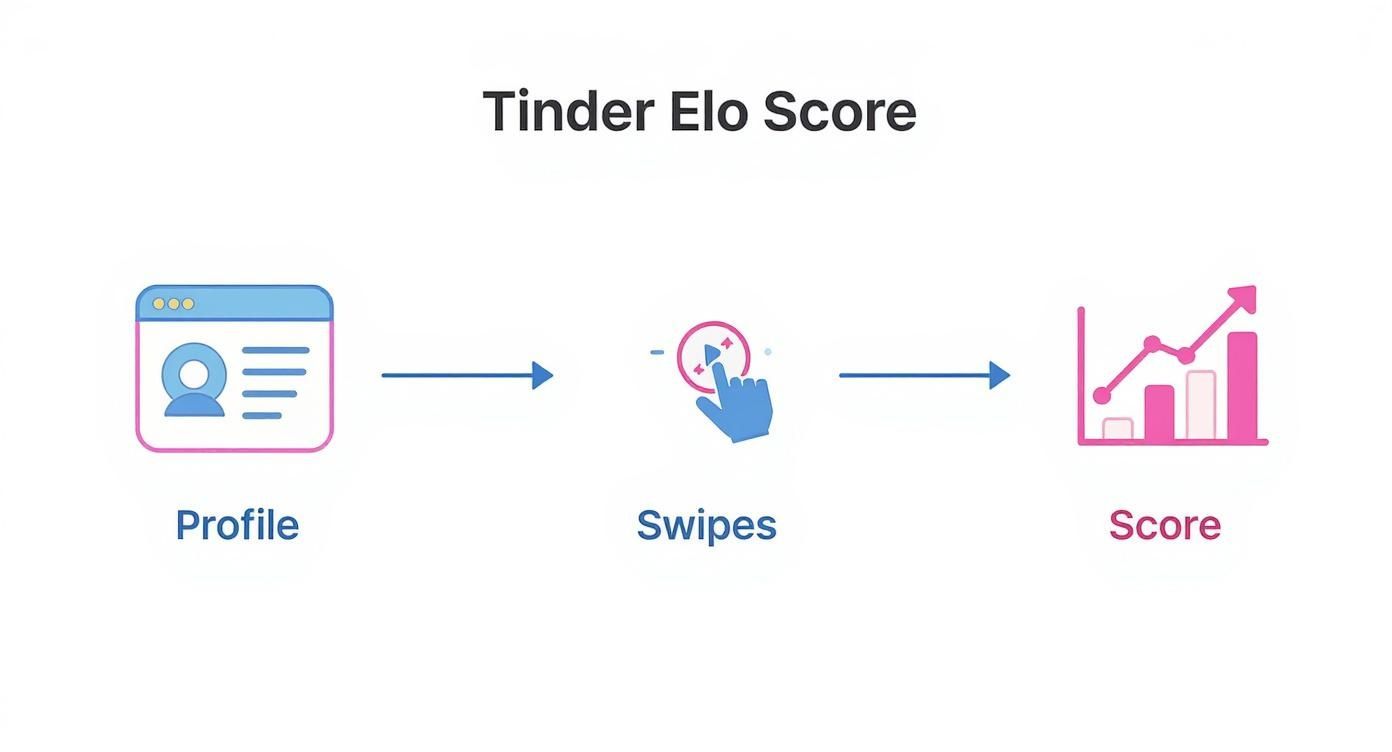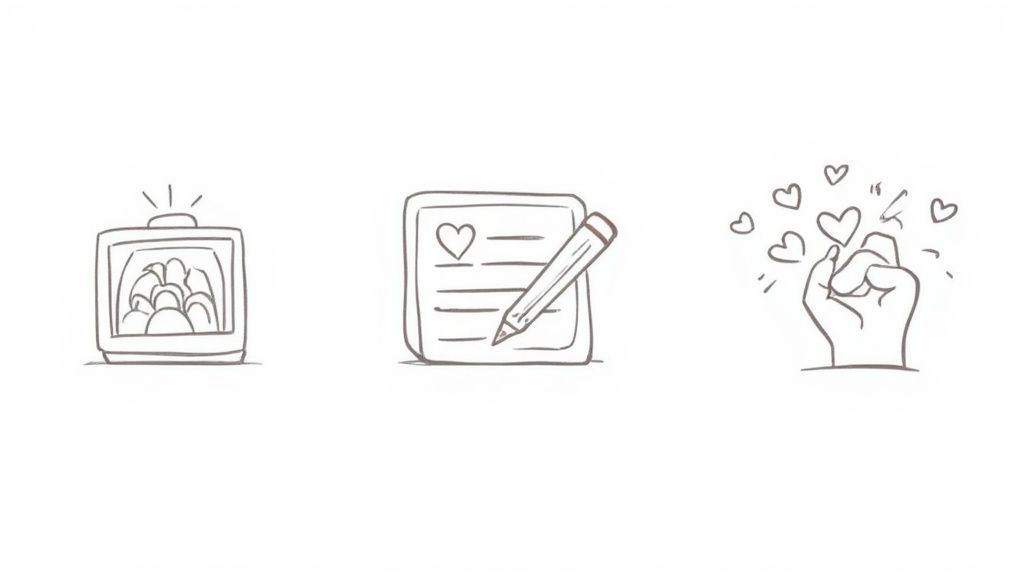Mastering the Elo Score Tinder Uses

For years, the Tinder Elo score was the secret sauce behind your matches—a hidden "desirability" rating that dictated who even got to see your profile. Think of it like a secret leaderboard for dating. A high score put you in front of other top-tier users, while a low score could leave you feeling like you were shouting into the void.
What Was the Tinder Elo Score
Ever felt like you were swiping endlessly on Tinder with nothing to show for it? For a long time, the culprit was likely a hidden ranking system known as the Elo score. This wasn't just some random number; it was a powerful gatekeeper that essentially controlled your entire dating experience on the app.
The whole concept was borrowed straight from the world of competitive chess. The Elo rating system, invented by Arpad Elo back in 1960, mathematically ranks players based on who they beat and the skill level of those opponents. Tinder just adapted this zero-sum game for dating. A 'win' was a right swipe, and the 'strength of your opponent' was how desirable the user swiping on you was. If you're curious about the nitty-gritty, you can explore the history of the Elo rating system on Wikipedia.
The Mechanics of the Score
So, how did this mysterious score actually work? The algorithm boiled down your swiping behavior and the attention you received into a single numerical value. A high score meant your profile was hot property, getting prioritized and shown to other in-demand users. This created a steady stream of quality matches.
A low score? You were effectively pushed to the back of the line.
The system was built on a few core principles:
- Who Swipes on You: Getting a right swipe from a user with a high Elo score gave your own score a serious boost. On the flip side, a left swipe from them could drag it down.
- Your Swiping Behavior: If you swiped right on literally everyone, the algorithm would peg you as less desirable—or even a bot—and tank your score. Being selective was the key to climbing the ranks.
- Initial Placement: When you first joined, Tinder would put your profile in front of a wide audience to quickly figure out your starting Elo score. This was often called the 'newbie boost.'
To give you a clearer picture, here's a simple breakdown of what mattered most.
How the Tinder Elo Score Worked
This table gives a simplified look at the core factors that used to influence your hidden desirability ranking on Tinder.
| Influencing Factor | Impact on Your Score |
|---|---|
| High-Elo User Swipes Right | Significant positive boost. |
| High-Elo User Swipes Left | Negative impact. |
| Low-Elo User Swipes Right | Small positive boost. |
| Selective Right Swiping | Positive. Showed you had standards. |
| Swiping Right on Everyone | Major negative impact. Flagged as spammy. |
| New Account ("Newbie Boost") | Initial high visibility to establish a baseline score. |
It was a pretty straightforward, if ruthless, system.
At its heart, the Elo score created a feedback loop. High-rated profiles were shown to other high-rated profiles, reinforcing their status. This created what some called a 'Tinder elite,' while others struggled for any visibility at all.
This system was pretty controversial because it essentially created a tiered dating market. While Tinder has since claimed to have moved on to a more complex system, the legacy of the elo score tinder still casts a long shadow on how modern dating algorithms function.
To get a better handle on the current system, you should check out our guide on how the Tinder algorithm works.
How Elo Created a Vicious Cycle of Matches
The Tinder Elo score wasn't just some number sitting in the background; it was an active, powerful force that shaped your entire dating life on the app. It turned what should have been a level playing field into a tiered system, trapping many users in a frustrating loop.
Think of it like this: two people create a new profile. One gets a few quick right-swipes from users who already have a high Elo score. The algorithm sees this, gives them a boost, and starts showing their profile to even more desirable people. This kicks off a positive feedback loop where success just breeds more success.
The Rich Get Richer Phenomenon
This dynamic quickly created what a lot of people called a "Tinder elite." If the algorithm decided you were hot, it would just keep amplifying your success. Your profile would get pushed to the top of the queue for other top-tier users, and the high-quality likes and messages would just keep rolling in.
But what about the other person? If they got a few left-swipes early on from high-scoring profiles, their Elo score would plummet. Once that happened, the algorithm would basically demote them, showing them mostly to less active or less desirable users. Getting a match suddenly felt like an impossible task, locking them in a cycle of invisibility.
It was a pretty brutal system that directly shaped your journey on the app from day one.

This visual really breaks down how your first few swipes could either set you up for success or bury your profile at the bottom of the pile.
A System of Haves and Have-Nots
The impact of this tiered system was massive. Back when the Elo score was in full swing, a small group of users pretty much dominated the app. Unofficial studies from that time suggested that this elite group, estimated to be just 10–20% of users, got a ridiculously unfair amount of attention. They were the ones getting Super Liked constantly and always appearing first, gobbling up more than half of all daily matches in big cities. You can dig into some of the data behind Tinder's desirability rankings at hovalo.com.
This created two completely different versions of Tinder:
- The Top Tier: These users saw a constant stream of great matches and conversations. For them, the app felt alive, fun, and packed with opportunity.
- The Lower Tiers: Everyone else struggled. Low visibility, almost no matches, and a ton of frustration. They were left wondering why the app just wasn't working for them.
The real problem with the Elo score was its self-reinforcing nature. Success bred more success, while an initial lack of it could lead to a downward spiral of algorithmic punishment, making it incredibly difficult to recover.
For countless people, the system wasn't a matchmaking tool—it was a source of endless confusion and disappointment, leaving them completely stuck in a cycle of digital invisibility.
Moving Beyond the Original Elo Score
Tinder officially announced they’ve moved on from the classic Elo score, but don't be fooled—that doesn't mean your internal ranking just vanished. The system simply evolved.
Think of it as upgrading from a basic calculator that only tracks wins and losses to a supercomputer crunching hundreds of interconnected signals at once. It’s smarter, faster, and way more detailed.
This modern algorithm is far more intricate. It looks past the simple yes-or-no of right and left swipes to understand how you actually use the app. The system now sizes up the quality of your profile, your messaging habits, and even how picky you are with your own likes. So while the "Elo" name might be retired, the core idea of a desirability score is more powerful than ever.
The New Algorithm in Action
What does this new system care about? Engagement. It's all about user behavior. It's not just about who swipes right on you, but what you do after you get the match. The goal is to spark real conversations, not just rack up a high match count.
Here are a few key signals the new algorithm is likely tracking:
- Message Engagement: Are you sending the first message? Are your matches actually replying? Quick, engaging back-and-forth signals to Tinder that you're a high-quality, active user.
- Profile Completeness: A well-written bio, a linked Instagram or Spotify, and a full lineup of varied photos all feed positive data points into the algorithm. A lazy profile gets lazy results.
- Selective Swiping: Mindlessly swiping right on every profile is a huge red flag. Being selective shows you’re making thoughtful choices, and the system rewards that.
The new algorithm's main job is to figure out your type and predict compatibility based on what you actually do. It rewards people who act like they're trying to connect, not just playing a numbers game.
Essentially, Tinder wants you to be a good citizen of its app. It pushes profiles that add to the ecosystem by being active, engaging, and thoughtful. Your actions now have a direct and immediate impact on who sees you.
Is the Elo Score Really Gone?
Tinder publicly stated it moved away from a pure Elo system sometime between 2018 and 2019. But here’s the thing: elements of its logic are still very much alive.
While the company now uses complex machine learning that analyzes a ton of user activity, both user feedback and expert analysis show that profiles still get a major boost from a high match-to-like ratio. That was the central pillar of the old Elo philosophy.
This means that while the formula has changed, the outcome is pretty similar: your perceived desirability still calls the shots. The more you learn about how likes work on Tinder, the clearer this becomes. Understanding this evolution is the first step to actually getting results on the app today.
Actionable Strategies to Boost Your Tinder Ranking

Knowing the theory behind the Tinder algorithm is one thing, but actually turning that knowledge into a steady stream of matches? That’s the real goal here. Boosting your internal ranking—whether it’s an official elo score tinder still uses or not—boils down to signaling high value and engagement to the system.
The good news is you can start making some serious improvements today, just by focusing on your profile and your swiping habits. Think of your profile as your digital first impression. It has to be good enough to stop someone mid-swipe and make them think you’re worth a closer look. A few small tweaks can make a huge difference in how the algorithm sees you and who it shows you to.
Optimize Your Profile From the Ground Up
Your profile is your single most important asset on the app. Period. A lazy, low-effort profile signals to both users and the algorithm that you aren't a serious contender, and you'll be treated accordingly. So, start thinking of it as an advertisement for your best self.
Your photos are your primary weapon. This isn’t the place for blurry, pixelated shots. High-quality, clear pictures are completely non-negotiable. Your main photo needs to be a solo shot that clearly shows your face, ideally with a genuine smile. Ditch the sunglasses, the group shots (for the first pic, anyway), and anything that creates even a hint of uncertainty.
Next up is the bio. Instead of just listing generic hobbies, craft a bio that actually invites conversation. Include a question, a witty observation, or some kind of hook that makes it easy for someone to slide into your DMs. A complete profile, especially one with a linked Instagram or Spotify, tells the algorithm you’re an authentic, engaged user. For a deeper dive, our guide on how to improve your Tinder profile has even more specific tips.
In an era of AI-generated everything, making sure your pictures look genuine is also crucial for building trust. Authenticity stands out. As this helpful guide to images for authenticity points out, presenting a real, unfiltered version of yourself is the key to making a lasting positive impression.
To make this crystal clear, here’s a quick checklist comparing what a low-ranking profile looks like versus a high-ranking one.
Profile Optimization Checklist
| Profile Element | Low-Ranking Trait (Avoid) | High-Ranking Trait (Adopt) |
|---|---|---|
| Main Photo | Group shot, sunglasses, blurry | Clear solo shot, smiling face |
| Photo Variety | All selfies or all group photos | Mix of solo, activity, & social shots |
| Bio | Blank, generic, or just your height | Engaging, includes a question/hook |
| Profile Completeness | Basic info only | Linked Spotify/Instagram, interests |
| Authenticity | Overly edited or staged photos | Natural, high-quality pictures |
Following the "High-Ranking" column is your direct path to signaling value to the Tinder algorithm.
Master the Art of Strategic Swiping
How you actually use the app is just as important as what’s on your profile. Tinder's algorithm rewards thoughtful, human-like behavior and absolutely penalizes what it sees as spam or desperation.
Mindlessly swiping right on every single profile is one of the fastest ways to absolutely tank your ranking. This behavior immediately flags your account as low-value or, even worse, a potential bot. The result? Your visibility plummets.
So, be selective. Only swipe right on the profiles you are genuinely interested in. This simple change drastically improves your match-to-like ratio, which is a critical metric for the algorithm. A selective user is seen as a high-value user with standards.
And once you get a match? Engage with them quickly. Sending that first message soon after matching shows the algorithm you're active and actually invested in making connections. Meaningful conversations are rewarded, so please, avoid generic openers like "hey." Ask about something specific in their bio or photos to get a real dialogue going. This consistent, positive engagement is a powerful signal that will boost your standing in no time.
Common Mistakes That Destroy Your Ranking

Knowing how the Tinder algorithm works is only half the battle. So many guys torpedo their own profiles with critical mistakes, tanking their visibility without even realizing it. You can have amazing photos and a killer bio, but if your behavior on the app sends all the wrong signals, you'll still be stuck in a match-less wasteland.
These aren't just minor slip-ups; they are absolute ranking-killers. They basically tell the algorithm you're a low-value or totally disengaged user. Let's walk through these bad habits so you can stop the self-sabotage and give your profile the fighting chance it deserves.
The Mindless Right-Swipe
If there's one habit that absolutely nukes your score, it's this one: swiping right on every single profile you see. I get it, you think you're casting a wide net. In reality, you're telling Tinder you're desperate, spammy, or maybe even a bot. It’s the fastest way to get buried.
When you swipe right on everyone, your match-to-like ratio plummets. To the algorithm, this screams that you have zero standards. The system's response? It hides your profile from the more desirable users. Being selective is rewarded; being a mindless swiper is punished. Hard.
Neglecting Your Profile's Quality
Your profile is your one and only advertisement on Tinder, and a lazy ad gets zero clicks. The most common mistakes are often the easiest to fix, yet they do incredible damage to your score.
- Blurry or Low-Quality Photos: Grainy, poorly lit, or pixelated pictures just look low-effort. The algorithm knows this and prioritizes profiles with clear, high-quality images.
- The Group Photo Problem: Making a group shot your main picture is a classic blunder. It forces people to play "Where's Waldo?" and, spoiler alert, they won't bother. Your first photo needs to be a clear shot of just you.
- A Generic or Empty Bio: A blank bio is a huge red flag. It tells everyone you're not serious about this and gives potential matches absolutely no reason to start a conversation.
Think of your profile as a product on a shelf. If the packaging is blurry, confusing, or empty, no one is going to pick it up. The same logic applies to your Tinder profile.
Fumbling Post-Match Engagement
Nice, you got a match! But what you do next is just as crucial. Letting conversations die before they even begin sends a wave of negative signals to the algorithm.
If you rack up matches but never send a message, or if your conversations fizzle out after a single "hey," Tinder's system is watching. It concludes that you aren't creating good experiences for other users, which gets your profile demoted. A recent study by Forbes Health found that a whopping 79% of Gen Z users feel burned out by dating apps—and dead-end conversations are a huge part of the problem.
By steering clear of these common pitfalls—swiping selectively, putting real effort into your profile, and actually talking to your matches—you're sending a clear message to the algorithm: you're a top-tier user who deserves to be seen.
Should You Reset Your Tinder Account?
So, your matches have dried up, and you're starting to suspect your profile is buried deep in Tinder's digital dungeon. The thought of a "Tinder reset" starts to sound pretty good, right? A clean slate. A fresh start. It’s the nuclear option for escaping a bad score, but let's be real—is it actually worth it?
The appeal is obvious. Hitting reset promises a do-over, complete with that sweet, temporary "new user" boost. Tinder rolls out the red carpet for new accounts, putting your profile in front of way more people. If you’ve seriously upgraded your photos and bio since you first signed up, this feels like a golden ticket to make a better first impression on the algorithm.
The High Risks of a Reset
But hold on. This strategy is a minefield. Tinder isn't a fan of people trying to game the system, and they have ways of figuring out who’s trying to pull a fast one. Attempting a reset could get your account flagged or, even worse, shadowbanned. A shadowban makes you totally invisible without telling you, which is a whole lot worse than just having a low elo score tinder ranking.
Beyond getting on Tinder's bad side, a reset wipes everything:
- All your current matches vanish. That conversation that was just starting to get good? Gone.
- Every single conversation gets deleted. All the jokes, the plans, the connections you made—erased.
- Your history is wiped clean. The algorithm forgets you completely, which isn't always a good thing.
A reset is not a magic fix. If you delete your account only to pop back up with the same blurry photos and a one-line bio, you're just wasting your time. The algorithm will quickly figure you out and toss you right back to the bottom of the pile, maybe with an even worse score than before.
Making an Informed Decision
Before you even think about hitting that delete button, you need to have an honest chat with yourself. Have you really done everything you can to optimize your profile and swiping habits? If the answer is no, then a reset is just a band-aid on a bigger problem. The algorithm learns fast, and if your patterns haven't changed, your rank will tank all over again.
Think of a reset as your absolute last resort. It's the move you make when you're 100% certain your profile is killer, but you’re still hearing crickets. It’s a gamble, for sure. It could pay off with a massive visibility boost, or it could backfire and leave you in a worse spot than you started. Approach with caution, not desperation.
Answering Your Questions About the Tinder Score
Let's clear up some of the common questions and myths floating around about Tinder's ranking system. I get asked about this stuff all the time, so here are the quick, straightforward answers to help you get a handle on it.
Is the Elo Score Still a Thing on Tinder?
The short answer? Officially, no. Tinder announced a while back that they moved on from the classic elo score tinder system they used years ago.
But here’s the thing—the new algorithm works on very similar principles. It’s still analyzing how you behave, how much you engage, and how "desirable" your profile is to rank you. So, while the "Elo" name is gone, the core concept of a desirability score is very much alive and kicking. It's more of an evolution than a complete overhaul.
Your actions—like selective swiping and active messaging—are the most important signals you send to this new, more complex system.
How Quickly Can I Actually Improve My Score?
You can see changes a lot faster than you might think.
When you implement solid profile upgrades—like swapping in better photos and writing an engaging bio—you send immediate positive signals to the algorithm. Then, by sticking to smart, strategic swiping habits, you’ll reinforce that improvement over the next few days and weeks. It's a continuous process, but you're not waiting months to see a difference.

